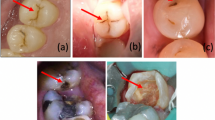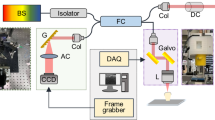Abstract
The aim of this study was to evaluate the ability of spectral-domain optical coherence tomography (SD-OCT) to display the roof of the pulp chamber and to estimate the residual dentin thickness (RDT) of the pulp complex. The roots of 20 extracted human molars were embedded in epoxy resin, and crowns were longitudinally sectioned in the mesial-distal direction, exposing the pulp chamber. The coronal part of the crown was removed up to an RDT to the pulp chamber roof of 2 mm. Samples were imaged by SD-OCT from coronal view and by light microscopy (LM) in the sagittal plane. Using a microtome, dentin was subsequently removed in four levels from the occlusal aspect in steps of 250 μm. At each level, RDT was documented and measured by both methods. The data were compared (Spearman’s rho correlation coefficient, Wilcoxon signed-rank test). Using OCT, the roof of the pulp chamber was first displayed at a maximum RDT of 1.94 mm. The minimal RDT that could be imaged by OCT was 0.06 mm. Values from both methods were strongly correlated (r, 0.83–0.95; pi ≤ 0.05) and differed significantly for large RDTs (dentin levels 1, 2; pi < 0.05) but not for small RDTs (levels 3, 4; pi ≥ 0.226). The roof of the dental pulp chamber could be already visualized by SD-OCT with a RDT of 1.94 mm. Therefore, the method could be a useful diagnostic tool during the preparation of deep dentin cavities and might help to preserve the integrity of the pulp chamber.



Similar content being viewed by others
References
Yu C, Abbott PV (2007) An overview of the dental pulp: its functions and responses to injury. Aust Dent J 52(1 Suppl):S4–S16
Schwendicke F, Frencken JE, Bjørndal L et al (2016) Managing carious lesions: consensus recommendations on carious tissue removal. Adv Dent Res 28:58–67
Lumley P, Adams N, Tomson P (2006) Practical clinical endodontics. Churchill Livingstone, Edinburgh
Murray PE, Smith AJ, Windsor LJ et al (2003) Remaining dentine thickness and human pulp responses. Int Endod J 36:33–43
Pameijer CH, Stanley HR, Ecker G (1991) Biocompatibility of a glass ionomer luting agent. 2. Crown cementation. Am J Dent 4:134–141
Pashley DH (1990) Clinical considerations of microleakage. J Endod 16:70–77
Schwendicke F, Dörfer CE, Paris S (2013) Incomplete caries removal: a systematic review and meta-analysis. J Dent Res 92:306–314
Mjor IA (2002) Pulp-dentin biology in restorative dentistry. Part 7: the exposed pulp. Quintessence Int 33:113–135
Mjor IA, Odont D (2001) Pulp-dentin biology in restorative dentistry. Part 2: initial reactions to preparation of teeth for restorative procedures. Quintessence Int 32:537–551
Braz AKS, Kyotoku BBC, Gomes ASL (2009) In vitro tomographic image of human pulp-dentin complex: optical coherence tomography and histology. J Endod 35:1218–1221
Stein S, Gente M (2013) Construction and in vitro test of a new electrode for dentin resistance measurement. Biomed Tech 58:469–474
Tielemans S, Bergmans L, Duyck J et al (2007) Evaluation of a preparation depth controlling device: a pilot study. Quintessence Int 38:135–142
Hatton JF, Pashley DH, Shunk J et al (1994) In vitro and in vivo measurement of remaining dentin thickness. J Endod 20:580–584
Fonsêca DDD, Kyotoku BBC, Maia AMA et al (2009) In vitro imaging of remaining dentin and pulp chamber by optical coherence tomography: comparison between 850 and 1280 nm. J Biomed Opt 14:24009
Fujita R, Komada W, Nozaki K et al (2014) Measurement of the remaining dentin thickness using optical coherence tomography for crown preparation. Dent Mater J 33:355–362
Kauffman CMF, Carvalho MT, Araujo RE et al (2006) Characterization of the dental pulp using optical coherence tomography. Proc SPIE Int Soc Opt Eng 6137:51–58
Colston BW Jr, Everett MJ, Da Silva LB et al (1998) Imaging of hard- and soft-tissue structure in the oral cavity by optical coherence tomography. Appl Opt 37:3582–3585
Wylęgała A, Teper S, Dobrowolski D et al (2016) Optical coherence angiography: a review. Medicine (Baltimore) 95:e4907
Ulrich M (2016) Optical coherence tomography for diagnosis of basal cell carcinoma: essentials and perspectives. Br J Dermatol 175:1145–1146
Vignali L, Solinas E, Emanuele E (2014) Research and clinical applications of optical coherence tomography in invasive cardiology: a review. Curr Cardiol Rev 10:369–376
Feldchtein F, Gelikonov V, Iksanov R et al (1998) In vivo OCT imaging of hard and soft tissue of the oral cavity. Opt Express 3:239–250
Schneider H, Park K, Häfer M et al (2017) Dental applications of optical coherence tomography (OCT) in cariology. Appl Sci 7:472
Machoy M, Seeliger J, Szyszka-Sommerfeld L et al (2017) The use of optical coherence tomography in dental diagnostics: a state-of-the-art review. J Healthc Eng 2017:7560645
Schneider H, Park K, Rueger C et al (2017) Imaging resin infiltration into non-cavitated carious lesions by optical coherence tomography. J Dent 60:94–98
Park K, Schneider H, Haak R (2015) Assessment of defects at tooth/self-adhering flowable composite interface using swept-source optical coherence tomography (SS-OCT). Dent Mater 31:534–541
Drexler W (2004) Ultrahigh-resolution optical coherence tomography. J Biomed Opt 9:47–74
Majkut P, Sadr A, Shimada Y et al (2015) Validation of optical coherence tomography against micro-computed tomography for evaluation of remaining coronal dentin thickness. J Endodod 41:1349–1352
Shimada Y, Sadr A, Sumi Y et al (2015) Application of optical coherence tomography (OCT) for diagnosis of caries, cracks, and defects of restorations. Curr Oral Health Rep 2:73–80
Meng Z, Yao XS, Yao H et al (2009) Measurement of the refractive index of human teeth by optical coherence tomography. J Biomed Opt 14:34010
Hariri I, Sadr A, Shimada Y et al (2012) Effects of structural orientation of enamel and dentine on light attenuation and local refractive index: an optical coherence tomography study. J Dent 40:387–396
Hariri I, Sadr A, Nakashima S et al (2013) Estimation of the enamel and dentin mineral content from the refractive index. Caries Res 47:18–26
Sinescu C, Negrutiu ML, Bradu A et al (2015) Noninvasive quantitative evaluation of the dentin layer during dental procedures using optical coherence tomography. Comput Math Methods Med 2015:709076
Schmalz G, Galler KM (2017) Biocompatibility of biomaterials - lessons learned and considerations for the design of novel materials. Dent Mater 33:382–393
Hargreaves KM, Goodis HE, Seltzer S et al (2002) Seltzer and Bender’s dental pulp. Quintessence, Chicago
Pashley DH (1996) Dynamics of the pulpo-dentin complex. Crit Rev Oral Biol Med 7:104–133
Stanley HR (1981) Human pulp response to restorative dental procedures. Sorter Printing Co., Gainesville
Camps J, Dejou J, Remusat M et al (2000) Factors influencing pulpal response to cavity restorations. Dent Mater 16:432–440
About I, Murray PE, Franquin JC et al (2001) Pulpal inflammatory responses following non-carious class V restorations. Oper Dent 26:336–342
Fujimoto JG, Pitris C, Boppart SA et al (2000) Optical coherence tomography: an emerging technology for biomedical imaging and optical biopsy. Neoplasia 2:9–25
Zijp JR, Bosch JJ (1993) Theoretical model for the scattering of light by dentin and comparison with measurements. Appl Opt 32:411–415
Mandurah MM, Sadr A, Bakhsh TA et al (2015) Characterization of transparent dentin in attrited teeth using optical coherence tomography. Lasers Med Sci 30:1189–1196
Wang X, Zhang C, Zhang L et al (2002) Simultaneous refractive index and thickness measurements of bio tissue by optical coherence tomography. J Biomed Opt 7:628–632
Uhlhorn SR, Borja D, Manns F et al (2008) Refractive index measurement of the isolated crystalline lens using optical coherence tomography. Vis Res 48:2732–2738
Shimamura Y, Murayama R, Kurokawa H et al (2011) Influence of tooth-surface hydration conditions on optical coherence-tomography imaging. J Dent 39:572–577
Azevedo CSD, Trung LCE, Simionato MRL et al (2011) Evaluation of caries-affected dentin with optical coherence tomography. Braz Oral Res 25:407–413
Acknowledgements
The authors would like to acknowledge Thorlabs GmbH, Dachau, Germany for providing the OCT.
Author information
Authors and Affiliations
Corresponding author
Ethics declarations
The study was conducted in accordance with the Declaration of Helsinki, and the protocols were approved by the Ethics Committee of the University of Leipzig. The extracted teeth were used on the basis of patients’ approval (informed consent, protocol no. 299-10-04102010).
Conflict of interest
The authors declare that they have no conflicts of interest.
Rights and permissions
About this article
Cite this article
Krause, F., Köhler, C., Rüger, C. et al. Visualization of the pulp chamber roof and residual dentin thickness by spectral-domain optical coherence tomography in vitro. Lasers Med Sci 34, 973–980 (2019). https://doi.org/10.1007/s10103-018-2686-3
Received:
Accepted:
Published:
Issue Date:
DOI: https://doi.org/10.1007/s10103-018-2686-3




